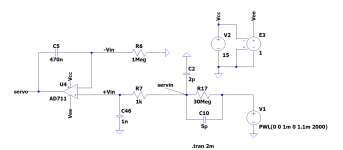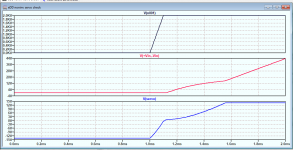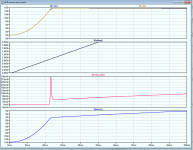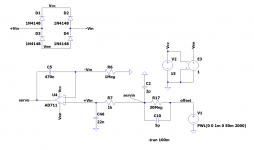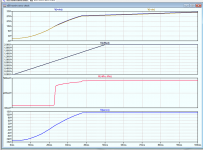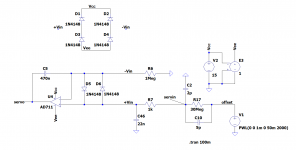We don't say this in the datasheet, but the back to back diodes are always sized to handle the short circuit current capability of the op amp output stage during transients. The 10mA given in the abs. max. table is a steady-state condition.@marcel: I know. I was looking for some capacitive paths for transients.
For transients, the output connects directly to the inverting input.
That could make the diff input voltage high. I think.
Maybe put a resistor directly in series with the inv input?
Jan
One idea I had was look at the servo operation in itself. Its an integrator and will quickly exceed all max specs when fed with a DC voltage - the output keeps on climbing, unchecked. The saving grace is that it is supposed to throttle down that input offset through its feedback loop.
But, if it takes too long for the offset to be reduced by the feedback, the servo opamp is in trouble.
The throttling down can take too long if the time constant is excessive, or - if the initial offset is very high. Like 2kV.
The attached shows what happens when the feedback loop isn´t there, and it is clear that if it takes more than a ms or so to reduce that initial offset, something has to give. The opamp output slams into the rail, but the input differential goes through the roof. (I know that some of the values are probably not exactly right - it's the principle I want to expose).
Jan
But, if it takes too long for the offset to be reduced by the feedback, the servo opamp is in trouble.
The throttling down can take too long if the time constant is excessive, or - if the initial offset is very high. Like 2kV.
The attached shows what happens when the feedback loop isn´t there, and it is clear that if it takes more than a ms or so to reduce that initial offset, something has to give. The opamp output slams into the rail, but the input differential goes through the roof. (I know that some of the values are probably not exactly right - it's the principle I want to expose).
Jan
Attachments
Are you sure that op amp spice model includes back-to-back diodes? The input differential voltage can only increase if there is a substantial amount of current flowing through those diodes.
The place-holder opamp in the schematic does not have input protection diodes (DM input specced at +/-20V).
BTW The Vcc/Vee are totally separate and applied before the HV is enabled.
I did notice that with antiparallel diodes on the inputs, it takes a second or so for the offset to go down to zero. Without those diodes it goes much faster.
Sounds logical.
As noted, the problem was gone after I switched to the OPA1642 (I am combining the chip with another opamp position).
Even without the discrete input diodes; presumably because the diodes towards the supplies will clamp the input pins.
See attached.
Jan
BTW The Vcc/Vee are totally separate and applied before the HV is enabled.
I did notice that with antiparallel diodes on the inputs, it takes a second or so for the offset to go down to zero. Without those diodes it goes much faster.
Sounds logical.
As noted, the problem was gone after I switched to the OPA1642 (I am combining the chip with another opamp position).
Even without the discrete input diodes; presumably because the diodes towards the supplies will clamp the input pins.
See attached.
Jan
Attachments
At the end of the day, your problem went away with the OPA1641. I was just trying to make the point that with an OPA172 in that circuit I don't think the op amp would ever experience a huge input differential voltage. The internal back-to-back diodes would clamp the voltage and the huge resistances in series with the inputs in your circuit would limit the current flowing in the diodes. Hence why I was thinking you might have a supply condition causing a latch-up of the op amp on power up. 1641 would be more resistant to this issue as well due to the dielectrically isolated process it's built on.
There are protection diodes to the rail as well. Again I don't think you could get anywhere near to 10mA through them in your circuit.
Jan, what kind of resistor do you use for the 32.4 MOhm resistor?
As jean-poul suggests, it may be a good idea to split it into a few resistors.
Unless it is a high-voltage type you may get sparks across the resistor if you apply 2 kV. In that case your current could become quite high.
As jean-poul suggests, it may be a good idea to split it into a few resistors.
Unless it is a high-voltage type you may get sparks across the resistor if you apply 2 kV. In that case your current could become quite high.
Jan, have you looked at the op amp power supply ramps with an oscilloscope? Do the rails come up together? Does one come up first while the other is in a high impedance state? Are there any fast transients on these rails?
Morning John, there are no fast transients I am aware of and the rails are just rectified and decoupled into 24uF @ 2.2kV, from the same xfrmr.
The amp draws 11mA but because the two halves of the totempole are not exactly balanced, comes up with a large neg offset which then is corrected by the servo. In operation, servo output is very close to zero volts.
I'll be away today, a Würth workshop on cables, connectors and crimping. 😎
Jan
The amp draws 11mA but because the two halves of the totempole are not exactly balanced, comes up with a large neg offset which then is corrected by the servo. In operation, servo output is very close to zero volts.
I'll be away today, a Würth workshop on cables, connectors and crimping. 😎
Jan
I think John meant the op-amp supplies. Is whatever is connected to the output of the servo able to push a substantial current into the op-amp when its positive supply rail goes negative, or pull substantial current from it when the negative supply rail goes positive?
The +/-15V supplies are separate and are switched on when the the tube heaters are switched on, and then after a delay the HV comes on.I think John meant the op-amp supplies. Is whatever is connected to the output of the servo able to push a substantial current into the op-amp when its positive supply rail goes negative, or pull substantial current from it when the negative supply rail goes positive?
During the warmup period, the servo output slowly drifts up because there's a small output DC before the HV comes on.
The servo opamp output feeds the circuit through perhaps 5k total load. As far as I know, the +/-15V stays up stable and clean during the start-up process, but I haven't looked at in detail. Apart from the tube outputs, everything runs on the +/-15 and I have not seen any anomalies. And, remember, the OPA1642 completely cured it with respect to the OPA2172, and the main difference between the two (in this context) is the input protection/DM input range.
Jan
Greetings everyone! Someone recommend me to ask this question in this thread since a lot of wiseman appeared here.
I really want to learn some knowledges about the analog semiconductor. Unlike the CPU\GPU\SoC sector, nearly everyone talked about "X nm", transistor count and etc. Very few audio-circuit amateurs will say something about the key technologies that makes our chip OPAMPs or even new BJT transistors better.
So, I·m curious about what have changed the analog semis in the past ten years?
From OPAMPs to the low noise LDOs and even the discrete transistors, too many high performance new models has came out within the decade, and what are the tech trend behand them?
I only know something that was stated on the official website, say TI has a ”high voltage CMOS“ tech that makes my old daddy stuned😎 .
I really want to learn some knowledges about the analog semiconductor. Unlike the CPU\GPU\SoC sector, nearly everyone talked about "X nm", transistor count and etc. Very few audio-circuit amateurs will say something about the key technologies that makes our chip OPAMPs or even new BJT transistors better.
So, I·m curious about what have changed the analog semis in the past ten years?
From OPAMPs to the low noise LDOs and even the discrete transistors, too many high performance new models has came out within the decade, and what are the tech trend behand them?
I only know something that was stated on the official website, say TI has a ”high voltage CMOS“ tech that makes my old daddy stuned😎 .
That new thread already exists, https://www.diyaudio.com/community/...ent-in-the-recent-decade.390394/#post-7125692 . I thought it would be a good idea to also ask it here, so @johnc124 could explain to what extent the OPA1656's CMOS process is better than those of 10 years ago - to the extent that it is possible to say anything about that without violating non-disclosure agreements.
Hi 🙂
I have just built a new line pre-amp with OPA 1656. You can read all about it here(with measurments)
J.R
I have just built a new line pre-amp with OPA 1656. You can read all about it here(with measurments)
J.R
Hi everyone. I came across this OPAMP completely by accident. I have a question, has anyone compared the sound of OPA1655 OPA1641 OPA 827 OPA828. I am currently using the OPA828 in my phono preamp in a "composite amp" configuration in tandem with LT1363 and BUF634A, the game is pretty cool with lots of detail and detail but the sound is sometimes quite dry and sterile, maybe using OPA1655 can improve things, finally it is " sound plus "and no OPA828, although it has much better input parameters, currently it's hard to buy OPA1655, but I can see that OPA828 is also not available in Mouser. I read the thread, but I did not find a comparison, maybe the constructor himself will advise something. Thanks for the hint and best regards !!
Last edited:
- Home
- Vendor's Bazaar
- OPA1656: High-Performance CMOS Audio Op Amp
